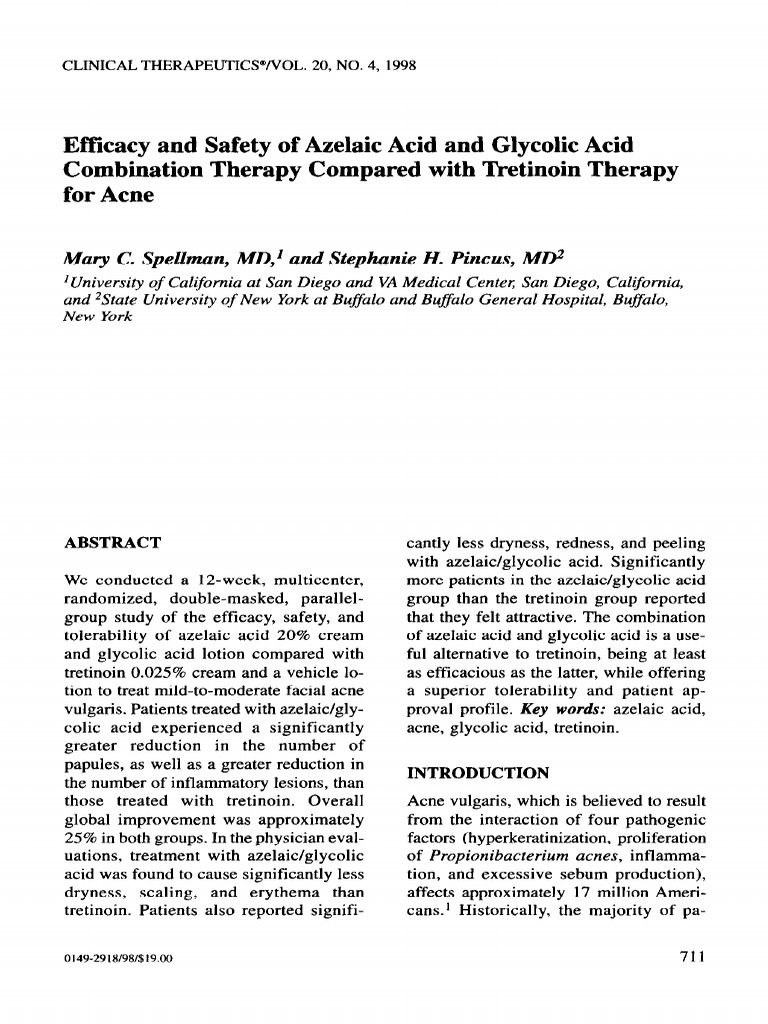Have you ever stood in front of your skincare shelf, pondering the possibility of mixing glycolic acid and azelaic acid? It’s a tantalizing thought, one that can prompt a whirl of questions. Are these acids a match made in skincare heaven, or could their concoction lead to a dermal disaster? This article dives into the science and artistry behind these acids, exploring their individual qualities, the potential benefits and pitfalls of combining them, and how to use them wisely.
Let’s start with the stars of the show: glycolic acid and azelaic acid. Glycolic acid, a member of the alpha hydroxy acid family, is celebrated for its exfoliating capabilities. It works by dissolving dead skin cells, revealing a brighter and smoother complexion beneath. This potent ingredient not only promotes cell turnover but also enhances the skin’s hydration levels, making it a go-to for combating dullness and uneven texture.
On the flip side, we have azelaic acid, which is often revered for its multifaceted benefits. While glycolic acid excels at exfoliation, azelaic acid boasts remarkable anti-inflammatory and antibacterial properties. This makes it particularly effective for redness, acne, and rosacea. Instead of simply stripping away the surface, azelaic acid is like a gentle maestro, harmonizing the skin’s defenses and addressing hyperpigmentation with finesse.
So now to the million-dollar question: can you mix these two acids together? The research suggests that the answer is yes, but with some caveats. Mixing them can amplify the benefits, theoretically combating acne and promoting skin renewal simultaneously. However, there is a potential challenge—sensitivity. Each skin type is unique, and combining potent active ingredients may lead to irritation for those with sensitive skin.
Here’s where it gets interesting. When layering glycolic acid with azelaic acid, the order of application becomes significant. When applying glycolic acid first, it can provide a superior exfoliating base, prepping the skin for azelaic acid’s soothing powers. In contrast, if azelaic acid is used first, it may mitigate some of the potential irritation that glycolic acid might cause. It creates an interesting balance; it’s like a skincare chess game.
Using these acids together demands a strategic approach. Begin by introducing them slowly into your regimen. Start with a low concentration of glycolic acid, perhaps 5% or less, and apply it every other night. After a week or two, once the skin has acclimated, consider integrating azelaic acid, either as a separate product or alternating nights. This gradual approach allows your skin to adapt without overwhelming it.
Additionally, pay attention to the formulation. Products vary widely in pH levels, consistency, and concentration. For instance, if you opt for a glycolic acid toner, be mindful of how it interacts with the azelaic acid cream you might be using. Sometimes, it’s also beneficial to look for products specifically formulated to combine these ingredients, which can offer a balanced approach right out of the box.
Now, let’s discuss frequency. Striking the right balance between these acids is crucial. Over-exfoliation can lead to a compromised skin barrier, resulting in long-term damage that takes age to repair. Adhere to a regimen that allows your skin to breathe. A good rule of thumb is to allow at least 48 hours between glycolic acid applications to minimize irritation, especially when it is combined with azelaic acid.
Another important aspect worth mentioning is sun protection. Both glycolic acid and azelaic acid can increase your skin’s sensitivity to the sun. Sunscreen becomes your best friend when incorporating these ingredients into your skincare routine. Utilize a broad-spectrum sunscreen with at least SPF 30 every day, regardless of the weather, to protect your skin and maintain the efficacy of the treatments.
For those with sensitive or reactive skin, performing a patch test would be wise. Apply a small amount of both products on an inconspicuous area of skin, like the jawline or behind the ear. This allows you to gauge how your skin responds without subjecting your entire face to potential irritation. Allow 24 hours to see if there are any adverse reactions before fully committing.
Moreover, keep an eye on your skin’s response. Adjust the usage based on how your skin feels. If you experience redness, irritation, or peeling, scale back. Your skin sends cues, and being attuned to them will help you achieve the best results. Embrace the journey and remember that skincare is a deeply personal experience—what works fabulously for one person might not suit another.
Ultimately, mixing glycolic acid and azelaic acid can be an enriching endeavor if approached correctly. With attention to formulation, application order, and skin sensitivity, you may just find that this powerful duo elevates your skincare routine. As you ponder the risks and rewards, remember that skin love is all about balance, patience, and adaptability. Enjoy the process of discovery while nurturing your skin to its healthiest and most vibrant self.
